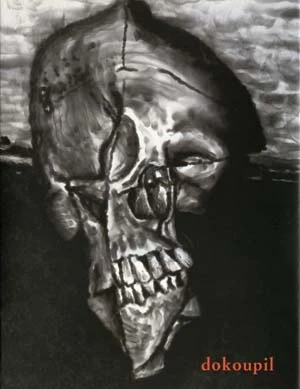Dokoupil. Querido amante del arte, soy un artista centroeuropeo

<p></p>
Dokoupil's work starts as a reaction to the rationality of conceptual art in the Seventies, while at the same time his painting evolves within a context defined by the resurgence of figurative painting in Germany, the Italian transavantgarde and the new generation of young painters from New York such as Jean-Michel Basquiat, David Salle and Julian Schnabel. That said, the formal diversity and prolific output of Dokoupil mean that it is difficult to firmly place him in any one specific trend; the mainstay of his work is the continual exploration of pictorial procedures, precisely reflected in this exhibition.
The exhibition starts out with his participation in the group Mülheimer Freiheit with a number of small drawings from 1978 to 1984, for instance Un pequeño sueño con ganso (1984) (A Small Dream About a Goose), Gente apilada (1981) (Piled People) and Buscadores de setas (¿no somos todos buscadores de setas?) (1980) (Mushroom Pickers, Are We Not All Mushroom Pickers?). Work that substantiates his incredible imagination and the richness of his personal universe.
Of the series from the Eighties, The New School of Cologne, created with Walter Dahn, stands out since the painting adheres to the same parameters: central idea/affirmation, blue sky, ochre platform, lighting from the right or left, etc. This is also joined by the series Blue Paintings about Love; Dokumenta-Paintings produced for Documenta 7; Theoretical Paintings and Terry Cloth Paintings, made with a sewing machine.
The 1984 series The Pacifier Paintings, out of which Two Fish, The Horse, The Telephone and Cigarette with Matches, among others, are exhibited, incorporates the childhood accessory as a metaphor for the new-born. Around the same time there is also The Apple Maiden series of works, acknowledged by Dokoupil as the peak of his abstract paintings, and in 1984 there are the Children Paintings, based on small porcelain figures and conceived as a new form of inspiration for kitsch.
The continual use of cocaine causes him to faithfully depict himself in the series Self-portraits with Bleeding Noses, and with a similar concept he produces the series Corporations & Products / Museums & Banks from which the sculptures: Exxon, Krupp, Maggi, Perrier and Bayer and the paintings Moma, Deutsche Bank and Rolex are exhibited, among other works.
The Eighties end with the cosmic series Esoteric Paintings, inspired by John Cage; the series Madonnas in Ecstasy, with the material taken from over 3,000 porn magazines, and the series Jesus Paintings, which includes Jesus in the Crown of Thorns and Jesus in Egg.
In 1988 in Madrid Dokoupil paints his first piece using smoke; the series of classic smoke paintings from 1988 to 1992 exhibited includes Subasta de Manet-11 Million Dollars, Naked from the Window, Space Between Two Cars. At the end of the Nineties, Dokoupil returns to this technique as he continues to experiment and produce works such as El hombre primitivo (The Primitive Man) and Retrato de un joven pintor de madera según Picasso (Portrait of a Young Painter in Wood, According to Picasso).
Candle smoke opens up a new route of direct experimentation on canvas, which continues until the Nineties. It leads Dokoupil to experiment with tires, fruit and soap bubbles, painting diverse series such as the The Green Paintings, signed as Dokoupilewa where the line is the amalgamation of points, the Closed-eye Paintings, the Unfinished paintings and the Impressionist paintings. By passing through each series produced by the Czech artist, the viewer can appreciate a whole collection of experiences on canvas and the idiosyncrasies and craft of his painting that is in a continual process of reinvention.
Artists
Organised by
Museo Nacional Centro de Arte Reina Sofía
Image gallery

